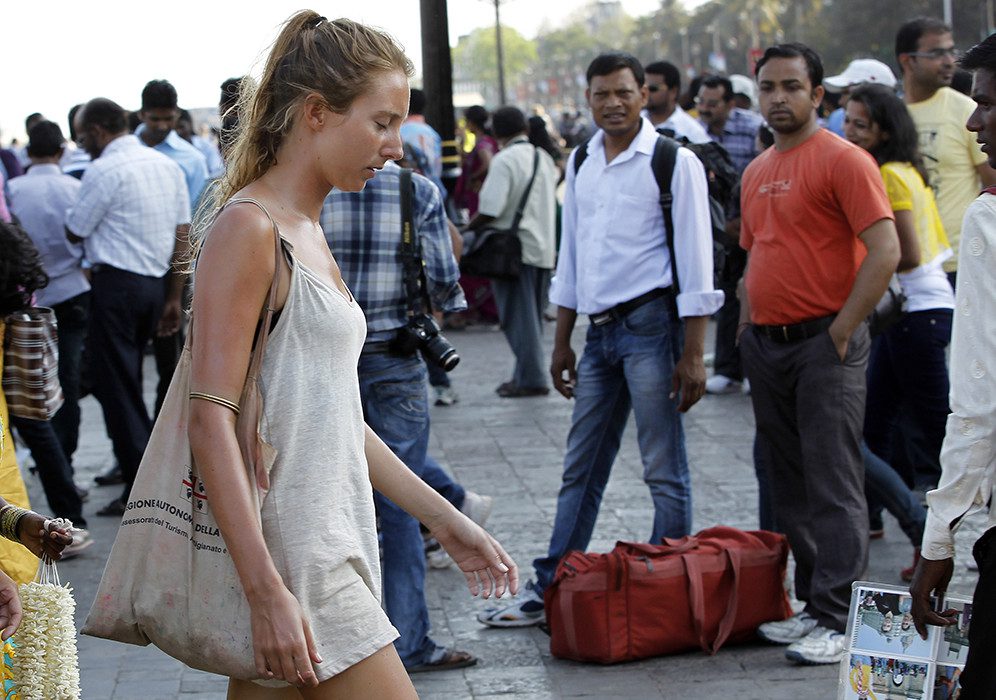The new Atithi Devo Bhava ads might be slicker than the original campaign, but carry some disturbing undertones.

But in the past month, a new set of hoardings has pushed its way onto the scene, clamouring for space amidst the politicians. The new ads are also governmental, but they are not part of any inter-party dispute; rather, they’re the latest salvo in the Ministry of Tourism’s Atithi Devo Bhava campaign.
Started in 2005, the campaign has sought to repurpose the well-known Sanskrit saying (loosely translated, “the guest is God”) for decidedly commercial purposes, arguing that India needs to treat its tourists better if it wants to increase its tourism revenue. The campaign got a big boost in 2009, when Aamir Khan signed up to be its brand ambassador—free of cost, no less.
Started in 2005, the campaign has sought to repurpose the well-known Sanskrit saying for decidedly commercial purposes, arguing that India needs to treat its tourists better if it wants to increase its tourism revenue.
A set of television ads were released shortly after this, featuring Khan in a role that, in retrospect, looks like a warm-up for Satyamev Jayate. The ads all open with Khan standing in front of a studio audience, reading a letter from a foreign tourist. It then cuts to a flashback of that tourist’s experience in India, and then cuts back to Khan, who calls up an honoured guest from the audience: the Indian who helped the foreigner in question.
The 2009 ads are a bit jarring, if only because they portray the clash between Indians and foreigner tourists with surprising candour. In one, two autorickshaw drivers start sexually harassing a white women on the streets of Delhi before a third driver intervenes and drives her to safety. In another, a white woman is convinced she is being overcharged by a vendor and yells at him when he follows her down the street, only to realise, somewhat sheepishly, that he is returning the purse she had left at his stall.
The first video evokes the usual middle-class disdain for auto drivers, but it still has a queasy effectiveness, especially because cases of assault and rape (including ones by auto drivers) are all too common, especially in Delhi. The second video, on the other hand, is effective because it so convincingly portrays the self-righteousness of the (white) tourist convinced she is being conned; the vendor is applauded because he does the right thing despite the tourist’s aggressive unpleasantness.
The ads’ effectiveness seems misdirected. Although the ads do, in the end, feature a heroic Indian, the conflict-laden scenes leave the viewer disturbed and wary both of predatory tour guides and condescending tourists, hardly the uplifting effect for which the ads strive.
But the ads’ effectiveness—that is, their ability to pack an emotional punch—seems misdirected. Although the ads do, in the end, feature a heroic Indian, the conflict-laden scenes leave the viewer disturbed and wary both of predatory tour guides and condescending tourists, hardly the uplifting effect for which the ads strive.
This has been remedied in the 2015 version of the ad campaign. (Is this yet another sign of the media prowess of the Modi government?) The hoardings, and even more, the new Aamir Khan ads, are positive and uplifting to a fault. The campaign has now been polished to a glossy sheen, all heart-tugging emotions and feel-good stories of selfless Indians intervening to help harrowed, hungry (and, in one case, pregnant) tourists. It seems there is little to object to in these high-production-value paeans to generousity and kind-heartedness. They’ve even gone beyond the usual colour palette by including black tourists—though they are still from a developed country (Canada).
And yet, beneath the slickness and political correctness, there are some disturbing undertones. It’s hard to escape the feeling that the ads are patronising. They are, at their core, morality plays aimed at the service-sector workers who interact with tourists with an utterly simplistic message: be nice to the tourist, and word of your niceness will spread even to the West.
It’s hard to escape the feeling that the ads are patronising. They are, at their core, morality plays aimed at the service-sector workers who interact with tourists with an utterly simplistic message: be nice to the tourist, and word of your niceness will spread even to the West.
In other words, forget the class difference that exists between you and the tourists. Forget, too, that the tourists are beneficiaries of a global economic system that enriches their countries at the expense of yours, both historically and in the present day. And certainly forget that your own government is taking an active role in this process, enriching a handful of Indians at the expense of the great majority of the population.
For the government, tourism—and the foreign currency that comes with it—is welcome, but what they’re really after is foreign investment of a different sort. They want foreign companies to come to India and will go to any length to prove their hospitality, from weakening labour laws to watering down environmental protections. Modi’s marketing team has come up with another memorable phrase, this one for attracting international capital: “from red tape to red carpet.”
Of course, not all foreigners are treated with the same warmth—this is true of both individuals and organisations. Black Canadians may be okay, at least in the realm of advertising, but black Africans face constant harassment, threats, and abuse. Foreign companies are certainly okay, even if they’re known for their labour abuses or their shoddy bookkeeping, but foreign NGOs questioning those companies are certainly out.
Of course, not all foreigners are treated with the same warmth—this is true of both individuals and organisations. Black Canadians may be okay, at least in the realm of advertising, but black Africans face constant harassment, threats, and abuse.
Thus, Priya Pillai, an employee of Greenpeace, has her travel restricted so that she cannot go to the UK and talk to British parliamentarians about Essar Energy, a company that is part of the unscrupulous India-based Essar Group, but is incorporated in the UK. Pillai is not a foreigner, but she works for a foreign NGO, and is thus “anti-national”. Essar is happy to hop around the world in search of tax loopholes—Essar Energy is now headquartered in Mauritius—but it does business in India (at the expense of the tribals and the environment, but no matter) and is thus “pro-national”. An even more telling case: the RSS receives massive amounts of foreign funding; but that’s OK, since they are thoroughly pro-national i.e. pro-Hindu.
In this context, it makes perfect sense that the new Atithi Devo Bhava ads were launched alongside a new brochure entitled ‘India—the Land of Yoga’. Yoga is the perfect fit for a BJP-run ad campaign: it can be easily monetised and marketed as a spiritual product, and it can be appropriated as yet another sign of orthodox Hindu preeminence—despite its long history as a heterodox tradition troubling to the mainstream arbiters of religious doctrine. The guest may be God; just make sure he’s a Hindu one.


